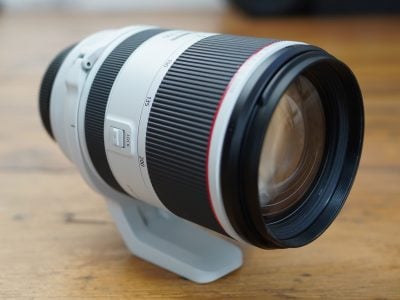Canon RF 70-200mm f2.8L IS USM review
-
-
Written by Gordon Laing
Intro
The Canon RF 70-200mm f2.8L IS USM is a bright telephoto zoom for the full-frame EOS R mirrorless system. Teased earlier in 2019 and officially announced in October that year, it’s shorter and lighter than the EF version and focuses closer too, although – spoiler alert – the barrel now extends as you zoom it, and it’s also unsurprisingly more expensive than the EF Mark III version which you can of course alternatively use on an EOS R with an adapter. So the new RF model better be good, and to find out I’ve made a bunch of comparisons with the EF Mark III version to help you decide which one to choose or whether it’s worth upgrading! I’ve put everything including my in-depth tests and results in the video below, but for those who prefer a written version, I’ll provide the highlights lower on this page. So if you’re looking for a top-quality 70-200mm zoom for your Canon mirrorless camera, you’ve come to the right place!
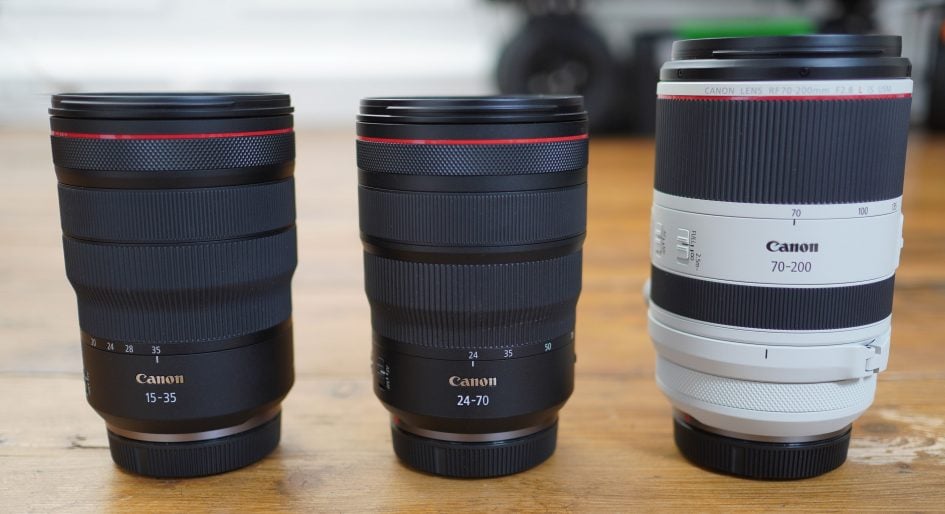
Above: The RF 70-200mm f2.8L joins the existing RF 15-35mm on the left and RF 24-70mm in the middle to complete the so-called Holy Trinity of professional f2.8 zooms. All three have L-quality optics, a fast and constant f2.8 focal ratio, weather-sealing and optical image stabilisation – and as you can see, they’re also remarkably similar in size.
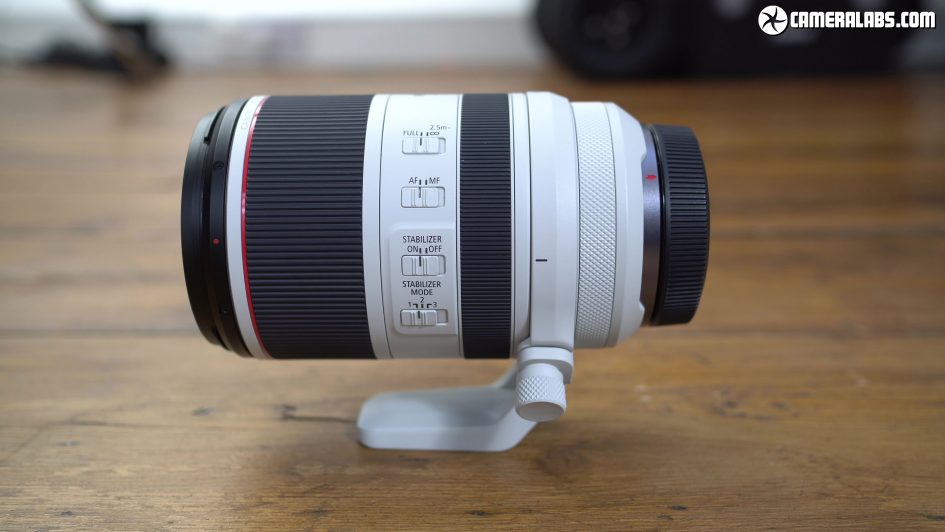
Above: Canon’s catalogue of RF lenses is certainly growing and already includes a couple of headline-grabbers, but despite its price, I’d argue the RF 70-200mm is the one that’ll really get people investing in the EOS R system. On paper it may simply appear to be a native version of a popular lens that’s become a staple of professional portrait, wedding and event shooters, but see it in person and you’ll immediately realise Canon’s created something truly unique. For starters just look at the size of it: at 90x146mm, it’s the shortest 70-200mm f2.8 zoom around.
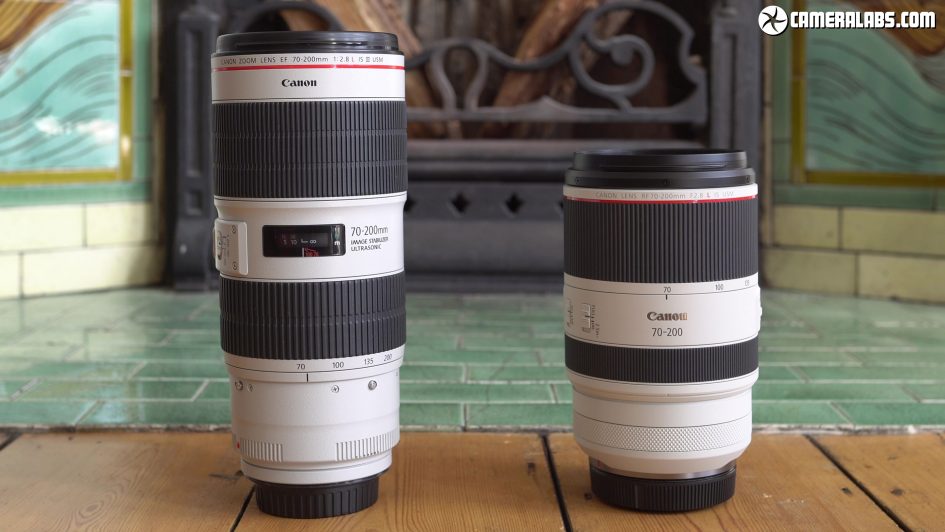
Above: Place it alongside the EF 70-200mm f2.8 Mark III and the difference is immediately clear – it may share roughly the same diameter, but it’s a considerable 53mm shorter, allowing it to be transported standing-up in many bags, when the old model needed to lie down.
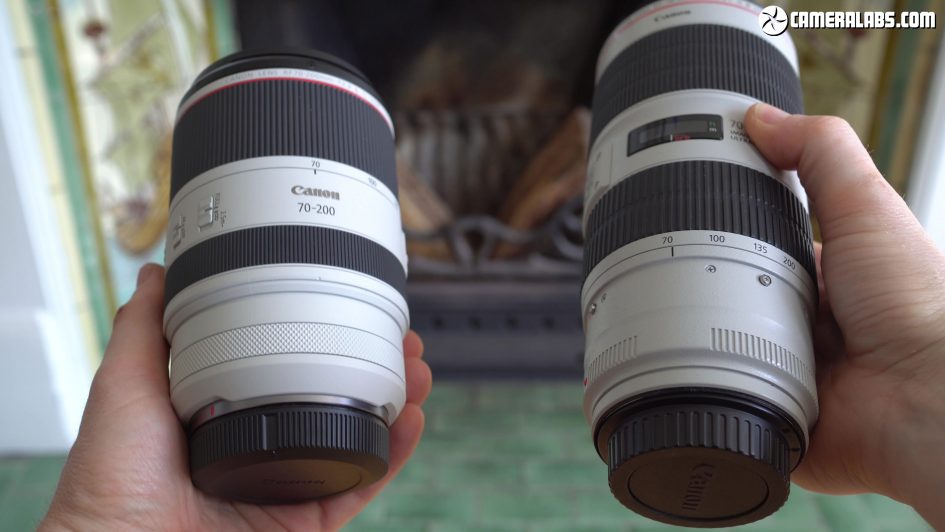
Above: It’s comfortably lighter too which means you may not be the one needing to lie down either after a day’s shooting: a relatively lightweight 1070g compared to 1480g for the Mark III EF version. So it’s roughly three quarters of the length and two thirds the weight, and that’s before taking an EF to RF adapter into account if you’re mounting it on an EOS R body. I know which one I’d prefer to carry around during a long event. The big question then is whether any of this has come at the cost of physical or optical quality, especially as the EF version was already so good, and I’ll answer that during the rest of this review.
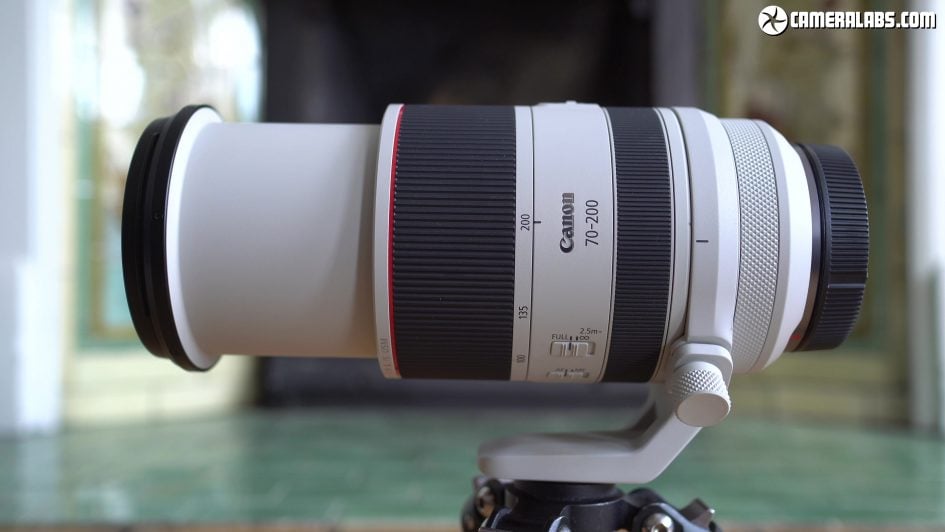
Above: The shorter length of the RF lens is thanks to a number of factors, but mostly due to it now employing an extending barrel, compared to the older EF version which zooms internally.
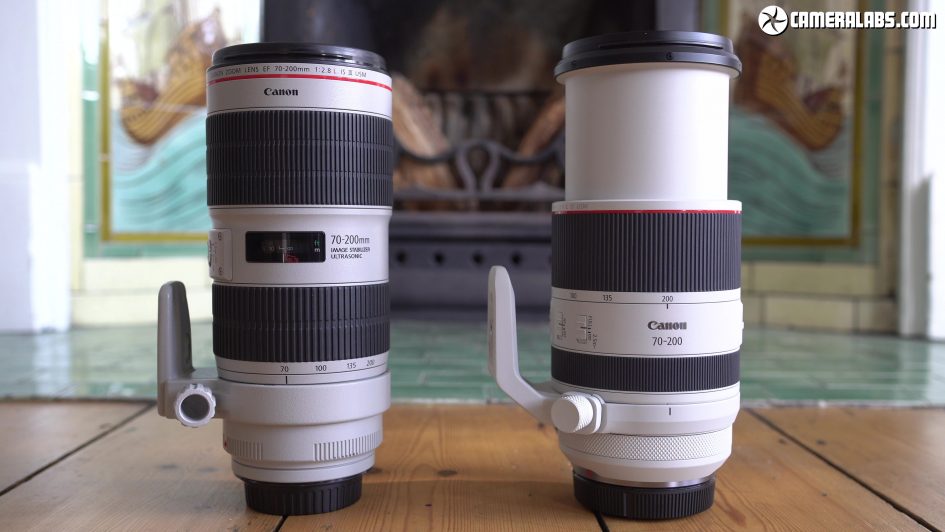
Above: So when the RF is zoomed to 200mm, the barrel extends to roughly match the length of the EF model. But crucially when you zoom it back to 70mm, the barrel retracts, giving you that greater portability, and there’s also a locking switch to hold it in position. Extending barrels may allow more compact designs, but introduce the risk of dust and moisture entering the system, but Canon’s employed various air filters in vulnerable areas to allow air to pass, but no unwanted particles; indeed it’s described as a weatherproof lens. Now I’ve only used it for a few weeks so can’t say how effective this will be long-term – only time will tell. But if you are concerned or simply interested in the build, I can highly recommend the Lens Rentals teardown article which shows what’s going on inside, including the doubling-up of parts for the zoom mechanism which allows the barrel to be virtually bereft of any play even when fully extended.
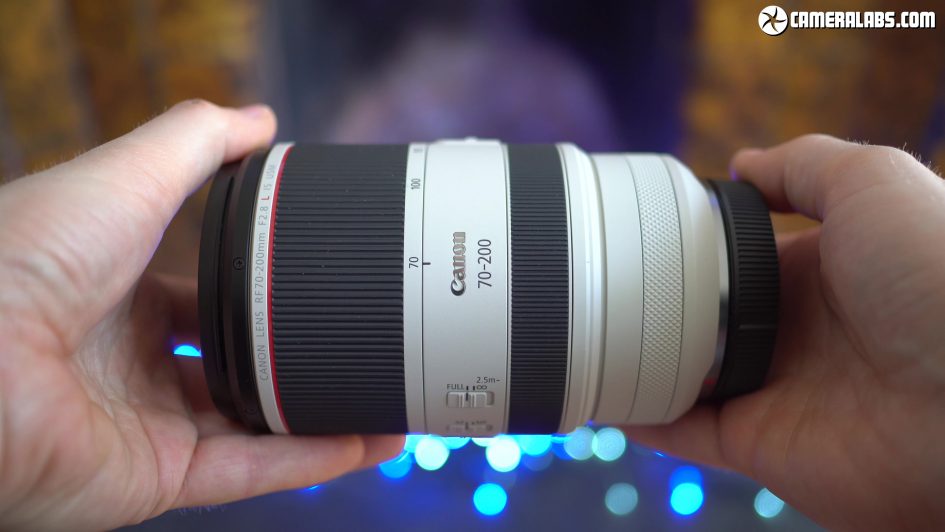
Above: In terms of materials, the RF 70-200mm employs engineering plastic for its barrel rather than the mix of metal and plastic for the EF version. Again I’ve not dropped or banged either lens, so can’t say whether one’s tougher than the other, but don’t assume metal wins for this kind of job. Canon’s adopted engineering plastics for all of its RF lenses so far without complaint.
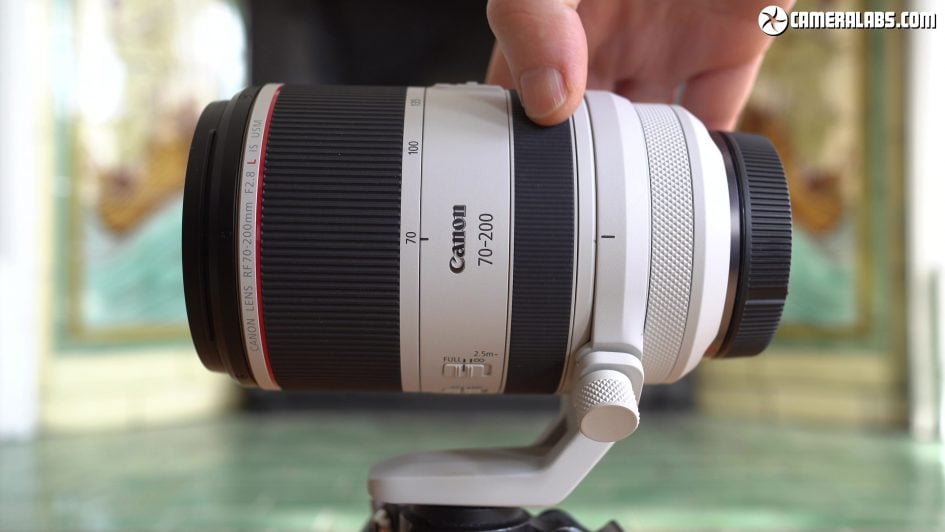
Above: In terms of design and use, owners of the previous EF version will need to readjust to having the position of the zoom and focusing rings swapped round. The focus ring on the RF version is not only closest to the lens mount, but narrower too and like most autofocusing mirrorless lenses, employs a motorised focus-by-wire system, rather than the mechanically-coupled system of the EF version. Oh, and as an RF lens, there’s also an additional control ring, this time closest to the mount, and customisable by the body.
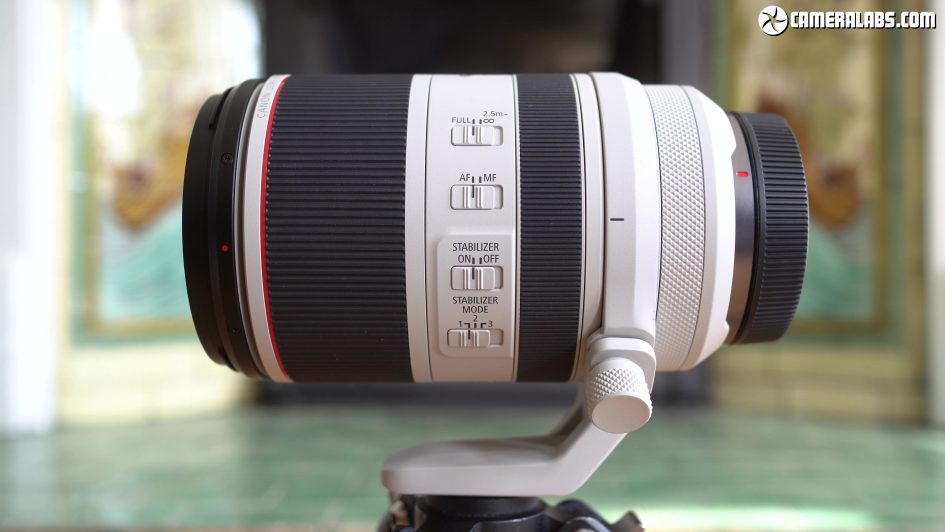
Above: Like the EF model, there’s four switches on the side of the barrel including a focus limiter that operates between 2.5m and infinity. Eagle-eyed Canon fans will notice there’s now three IS modes on the new RF version, with the new third option only activating stabilisation as you take the shot – this allows you to swing the lens around to follow a subject without the often distracting effect of the IS system trying to compensate, but still enjoy its benefit when you push the shutter down.
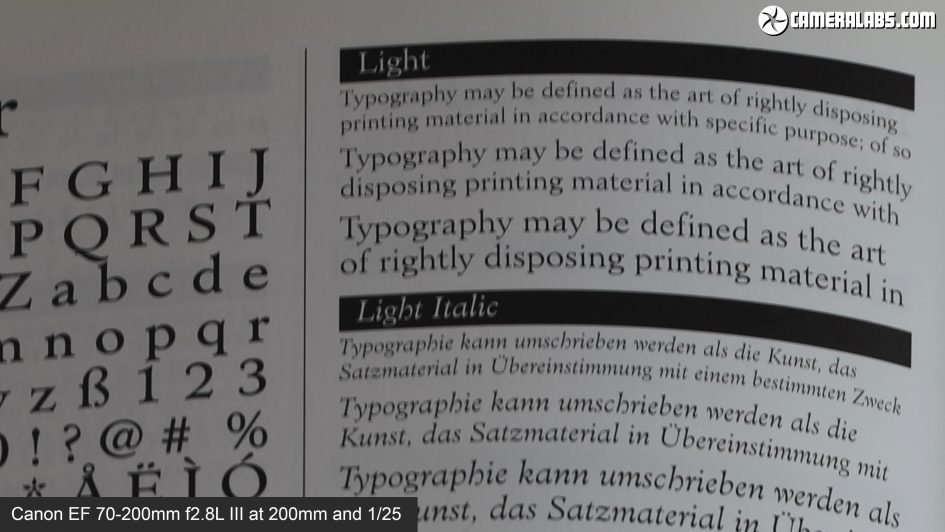
Above: It’s not just the third IS mode that’s new on the RF model, as Canon claims the degree of compensation has also been improved over the EF version, from 3.5 to five stops. In my tests, the slowest I could handhold the EF version at 200mm without stabilisation was 1/200; when IS was enabled, the slowest I could handhold a sharp image was between 1/25 and 1/13, corresponding to around 3.5 stops in this situation.
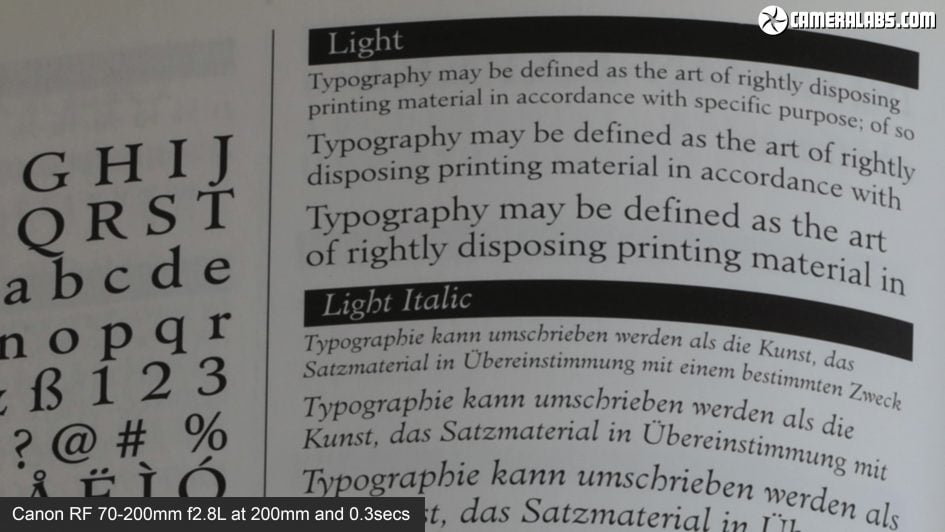
Above: On the newer RF version, the slowest I could handhold at 200mm without IS was 1/200, but with IS enabled, I could handhold a sharp result at 0.3 seconds, corresponding to six stops in this situation. So when it comes to still photography, the image stabiliser is measurably superior on the new RF lens in my tests.
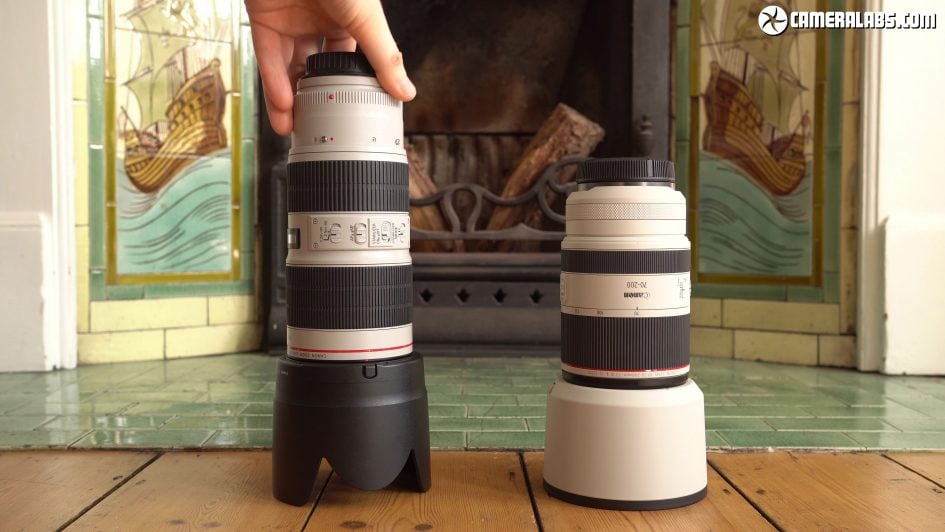
Above: Moving on, both lenses are supplied with lens hoods, but they’re quite different designs. The older EF model comes with a black petal hood compared to a white cylindrical hood with the RF version. In Canon’s World, the white hoods are seen as prestigious, normally reserved for the high-end super-telephotos, but in practical terms, the shape also makes it much more stable for standing-up – something I wouldn’t be happy doing with the petal hood.
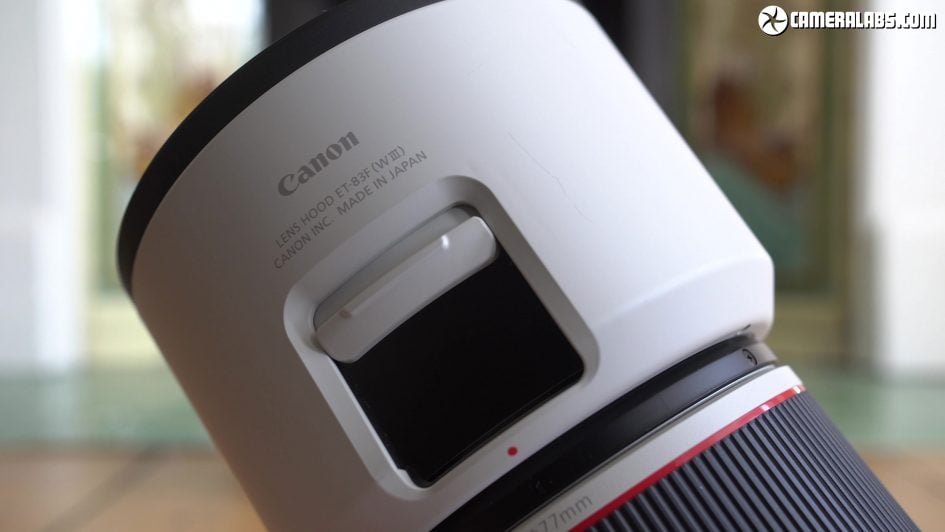
Above: Canon’s also included a small window in the hood, allowing you to reach-in and adjust a circular polariser more easily.
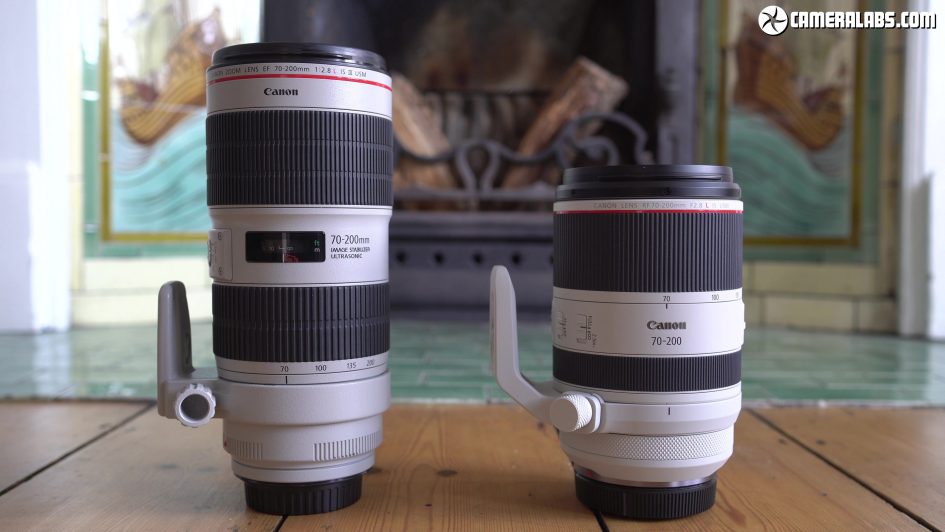
Above: Both lenses are also supplied with removeable tripod collars which not only allow more stable mounting, but also let you rotate the lens inside to easily switch between landscape and portrait orientations.
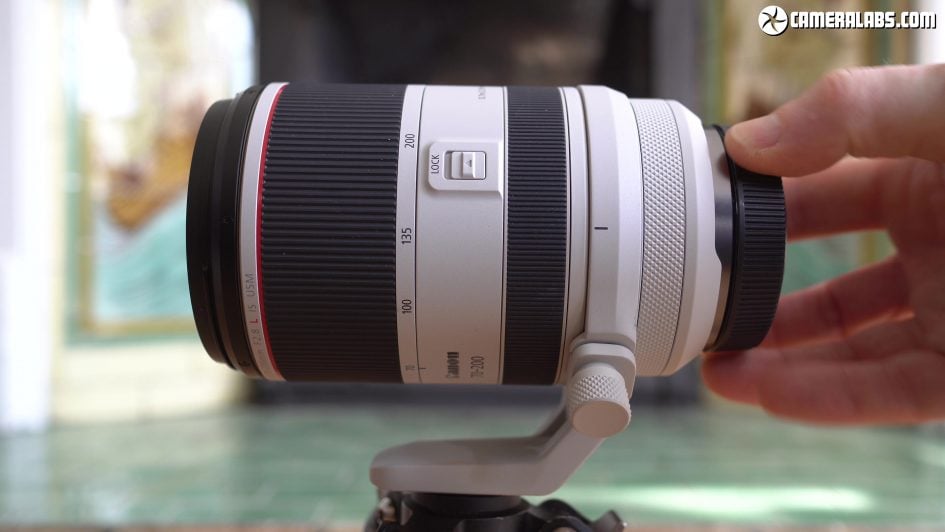
Above: Neither has notches for physical feedback at 90 degree intervals, so you’ll need to position them visually. The older EF lens has just one marking on its collar, but it’s easy to line-up with a line on the barrel that doubles-up to indicate the focal length.
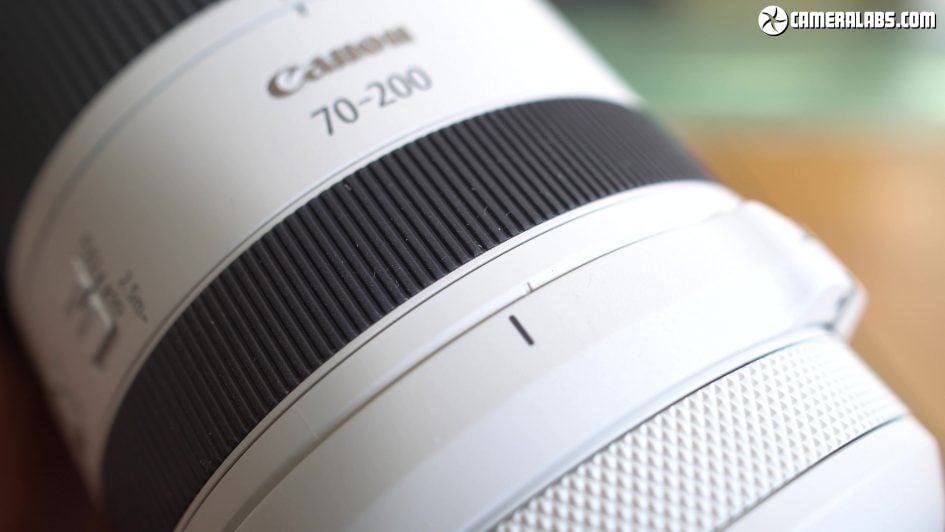
Above: In contrast, the RF collar has four smaller markings, but you’ll strain to even notice the tiny dent on the barrel to line them up with. I understand there wasn’t much room for a more obvious mark, but the bottom line is it’s unneccesarily hard to line-up the RF barrel when rotating it within the collar.
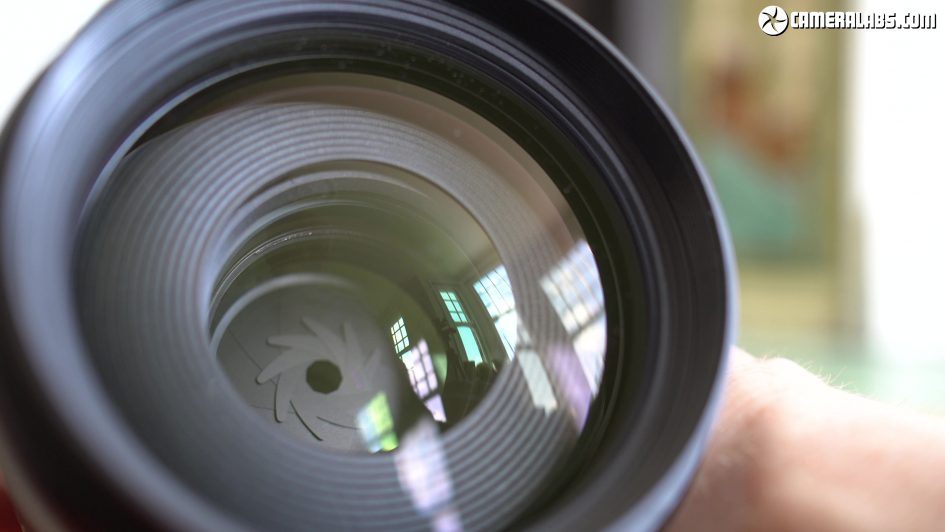
Above: Now onto autofocus and another major difference with the older EF version. The new RF 70-200mm becomes Canon’s first lens to employ a dual floating focus system with a pair of Nano USM motors working together. We’ve seen dual focus groups before on Sony lenses and like those models, it allows the Canon to focus closer than before. Beyond this, the actual focusing technology is smoother and quieter than the EF lens, making it better-suited to live view and movie use.
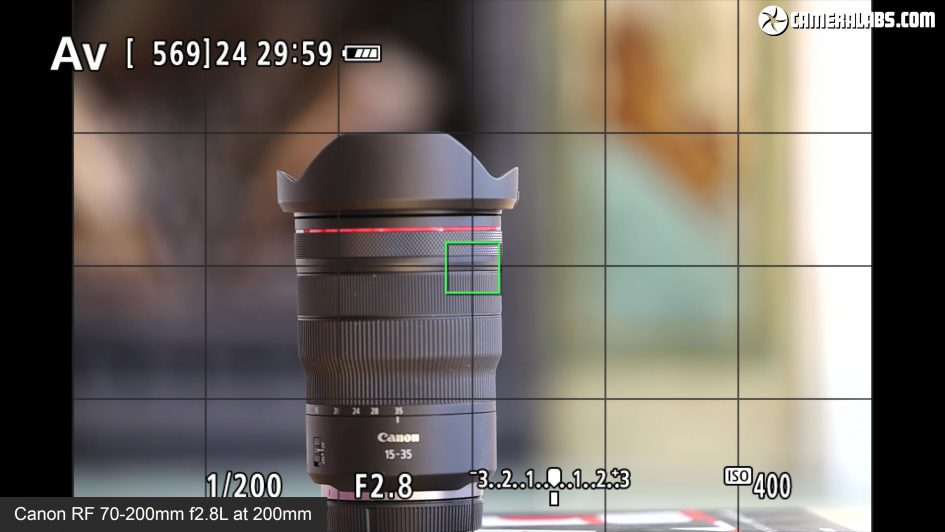
Above: Even with the challenge of a lowish-contrast subject at very close range, I’d say there’s little to choose between the two lenses in terms of autofocus speed for stills. They’re both very quick and snappy when using single AF areas.
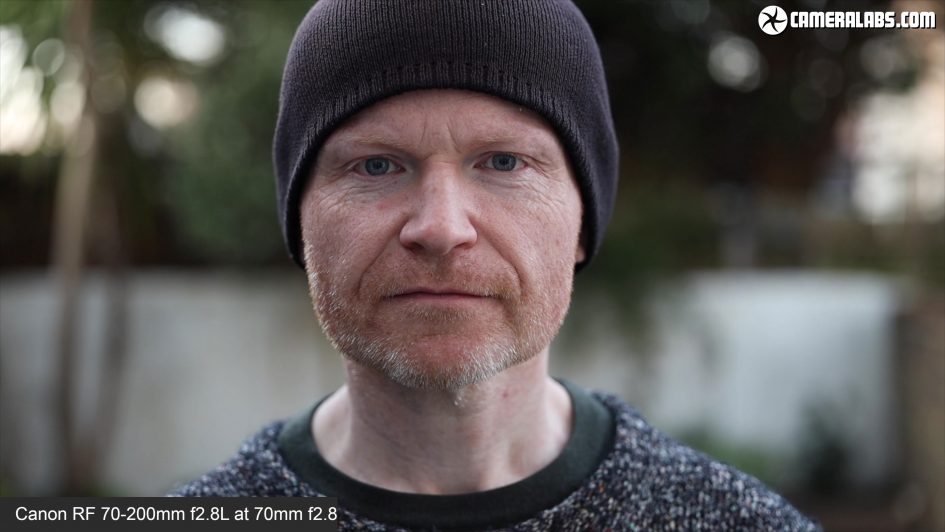
Above: When driven by face and eye detection on the EOS R, I anecdotally felt the RF lens felt a little more confident, which could be a factor for event photographers.
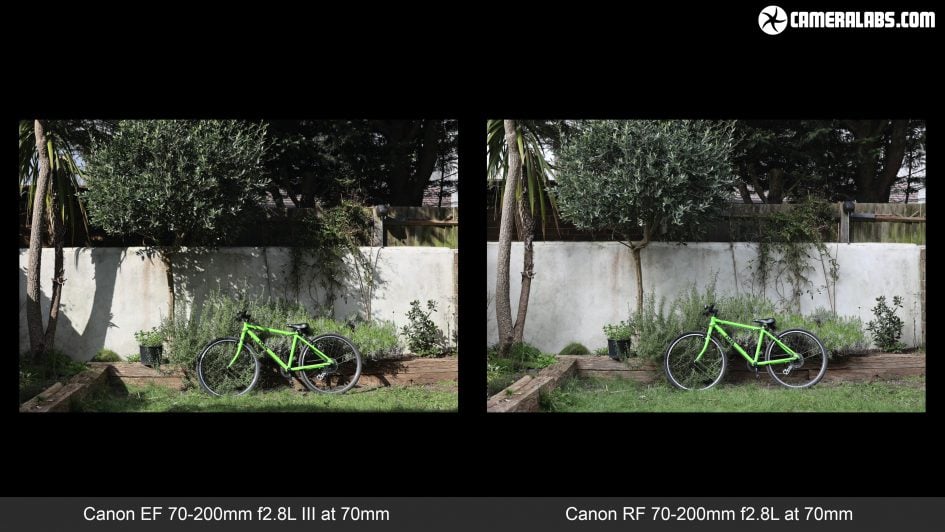
Above: In terms of closeups, the RF 70-200mm can now focus almost twice as close as the older EF Mark III model at an impressive 70cm vs 1.2m. However differences in focus breathing between the two models means the actual subject size you’ll be able to achieve may not be as much larger as you expected. To explain this, I’m going to show you some comparisons between both lenses shooting from the exact same position, first at 9m, then in a macro environment at 1.2m. On the left is a still photo taken with the EF 70-200mm, and on the right one taken with the RF 70-200mm, both at 70mm. Now there can be variations in actual coverage between some lenses which share the same quoted range, but from this shot, they’re both delivering essentially the same coverage at 70mm.
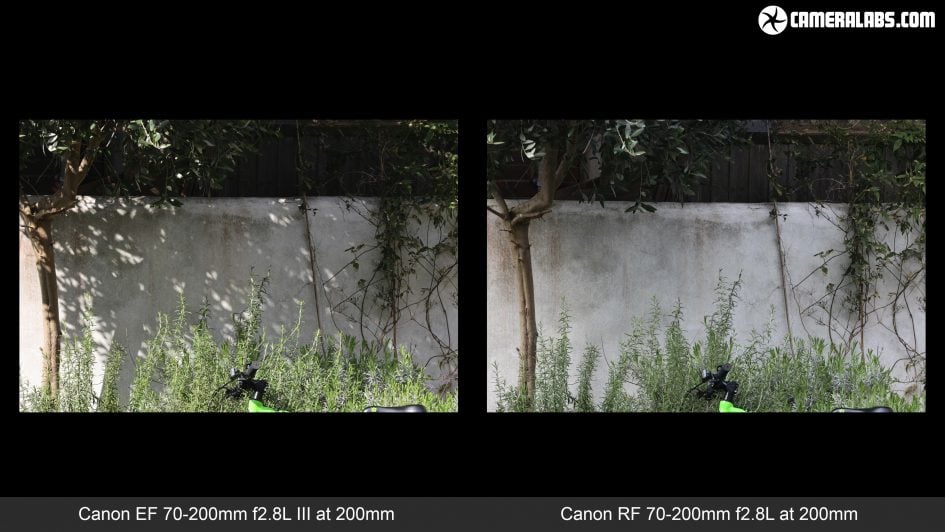
Above: And now here they are both zoomed to 200mm, and again from this distance their coverage is very similar, and if you compare the difference in magnification between 70 and 200mm, you get the expected result of around 2.85x. But what happens when you’re dealing with a closer subject?
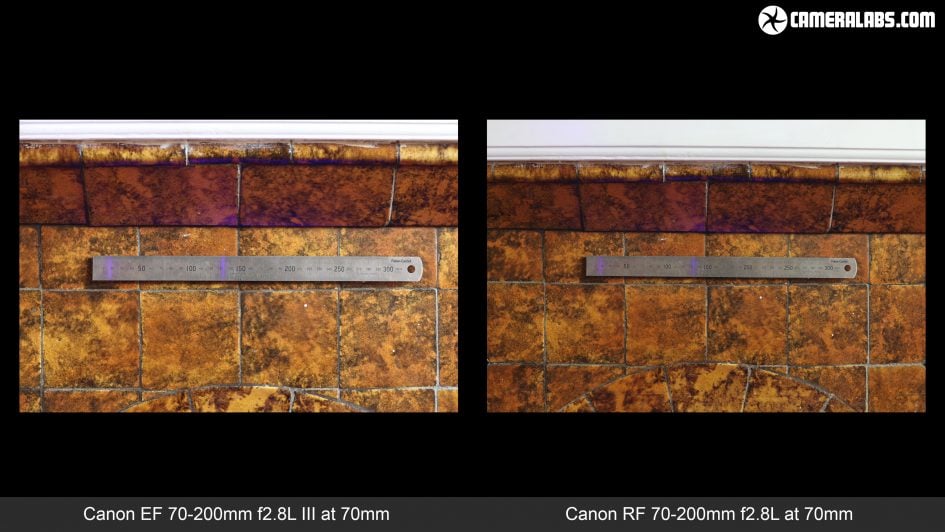
Above: On the left is a still photo taken with the EF 70-200mm, and on the right one taken with the RF 70-200mm, both at 70mm, but this time focused much closer, just 1.2m from the subject. Notice how the older EF version on the left is delivering a tighter view.
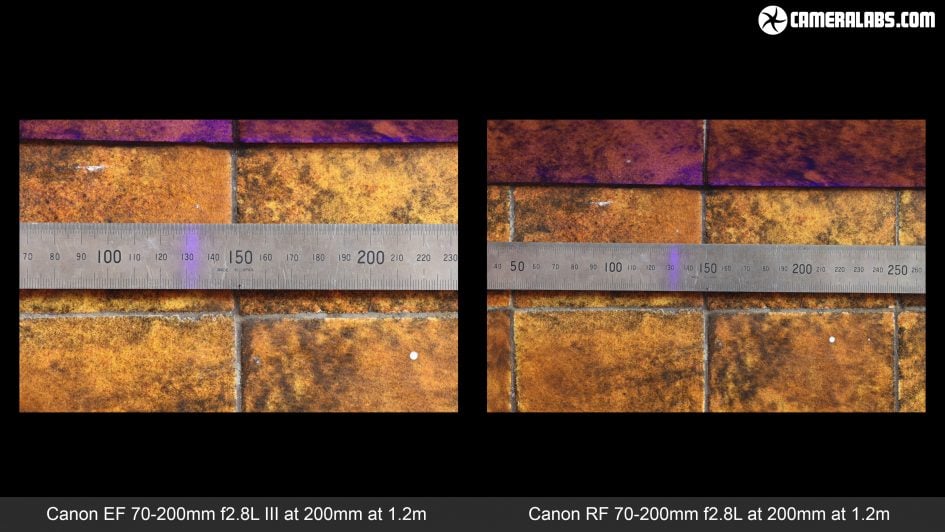
Above: And now both lenses, again from the same 1.2m distance, but this time at 200mm, and again the EF version on the left is more magnified. As you can see, the effect of focus breathing is detrimental to the new RF lens on the right when it comes to magnification in macro photography – it can’t deliver as large an image from the same distance, although it is at least looking sharper across the frame.
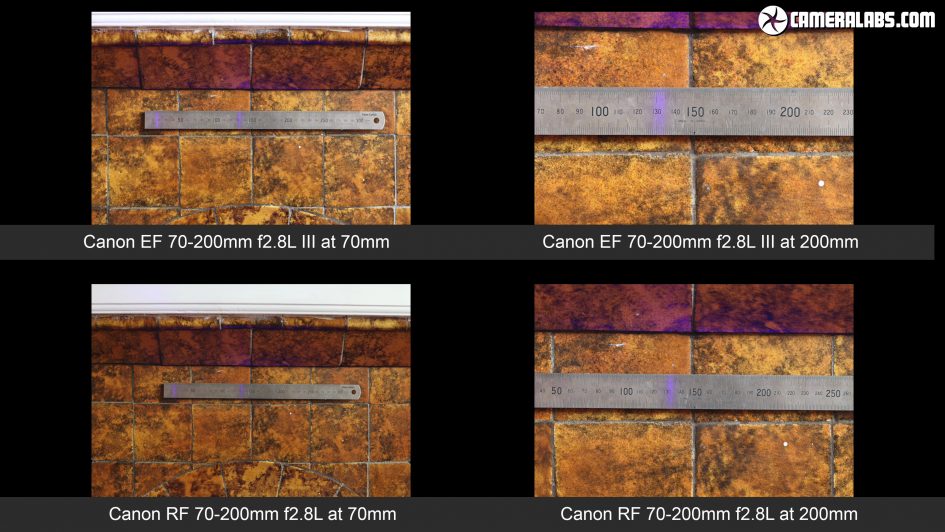
Above: When focused-close, both lenses suffer from a reduced effective range, but more so on the RF model. On the top row is the EF 70-200mm at 70mm on the left and 200mm on the right, while on the bottom row is the RF 70-200mm, again with 70mm on the left and 200mm on the right. All were taken at 1.2m, where the EF lens at the top is clearly delivering greater magnification than the RF lens at the bottom. Comparing their respective magnifications at 70 and 200mm also reveals the EF zoom’s range reduces to 2.62x versus 2.36x on the RF when both are focused at 1.2m. Both are reduced ranges compared to focusing at infinity where you’ll enjoy close to the 2.85x range you’d expect. That’s all very interesting, but which lens can actually deliver the biggest close-up? All these shots were taken from 1.2m which is the closest the older EF lens can focus. As you may recall, the newer RF model can get much closer at 0.7m.
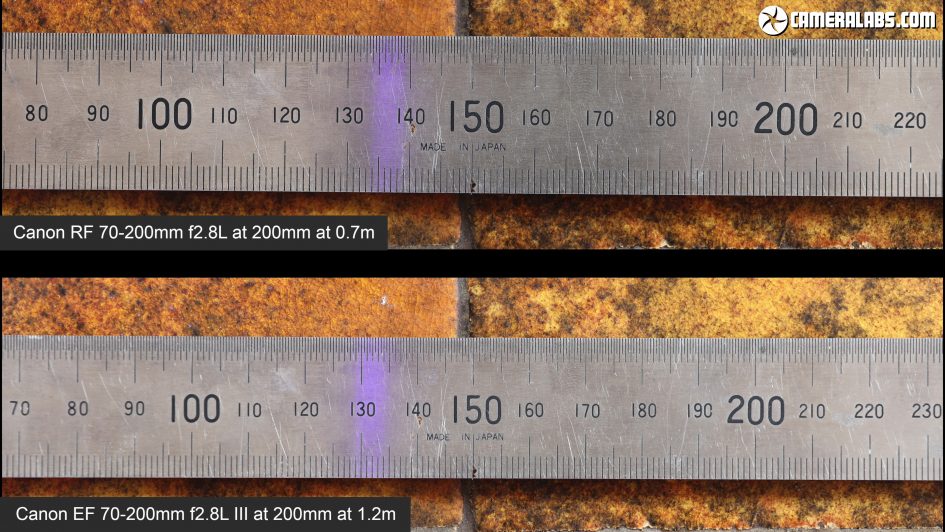
Above: So here at the top is the new RF version focusing as close as it can at 0.7m away, while at the bottom is the older EF model focusing as close as it can at 1.2m, both showing the full width of the frame. Despite the detrimental shrinking effect of focus breathing on the RF model when it comes to close-ups, the fact it can focus closer still, allows it to deliver a larger overall magnification – and as you can see, the RF version is also sharper across the frame, compared to the EF version which is a little softer in the middle and softer still at the edges. So overall a win for the RF lens when it comes to close-ups, but perhaps not with the increase in magnification you were expecting given it focuses almost twice as close.
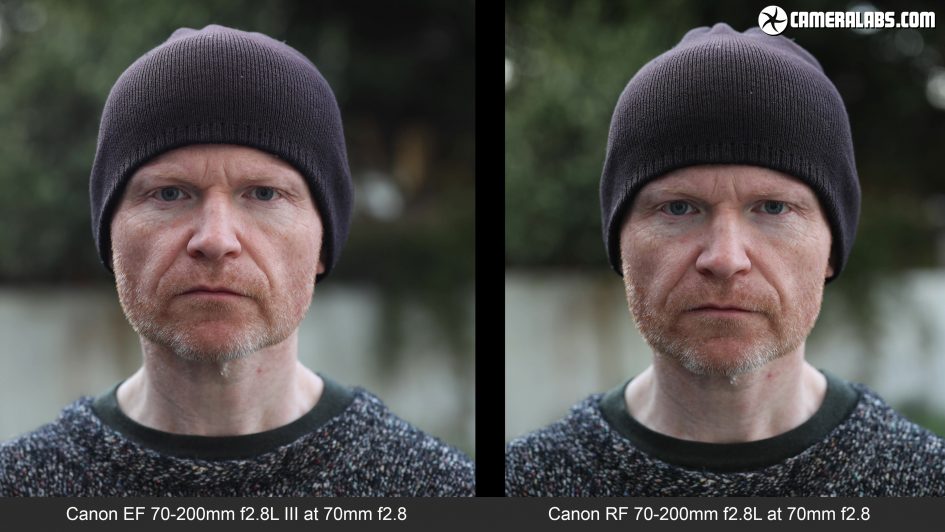
Above: Next it’s time for some bokeh, as both lenses are more than capable of blurring the backgrounds very nicely. I’ll start with portraits as these are of course a core subject for 70-200mm lenses. Here I am at 70mm f2.8 with the EF 70-200mm f2.8L III on the left and the RF 70-200mm f2.8L on the right.
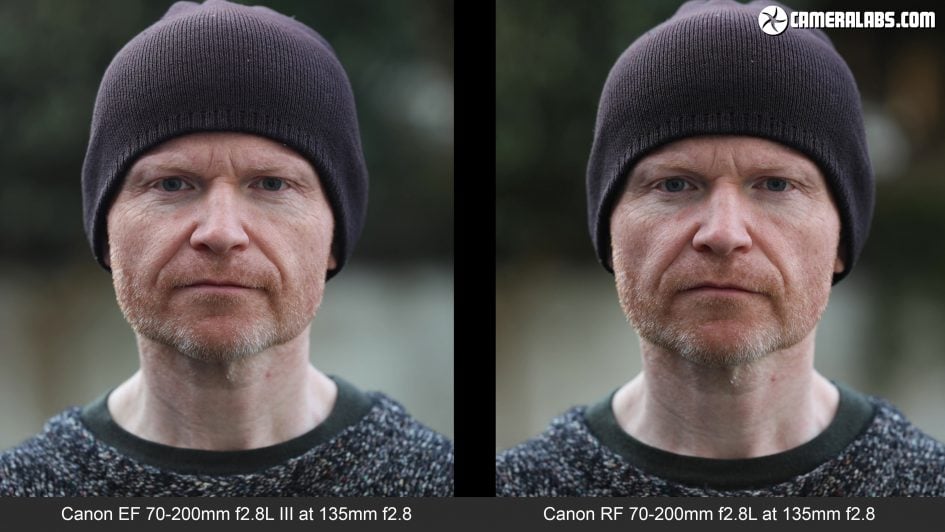
Above: And now at 135mm f2.8 with the EF 70-200mm f2.8L III on the left and the RF 70-200mm f2.8L on the right.
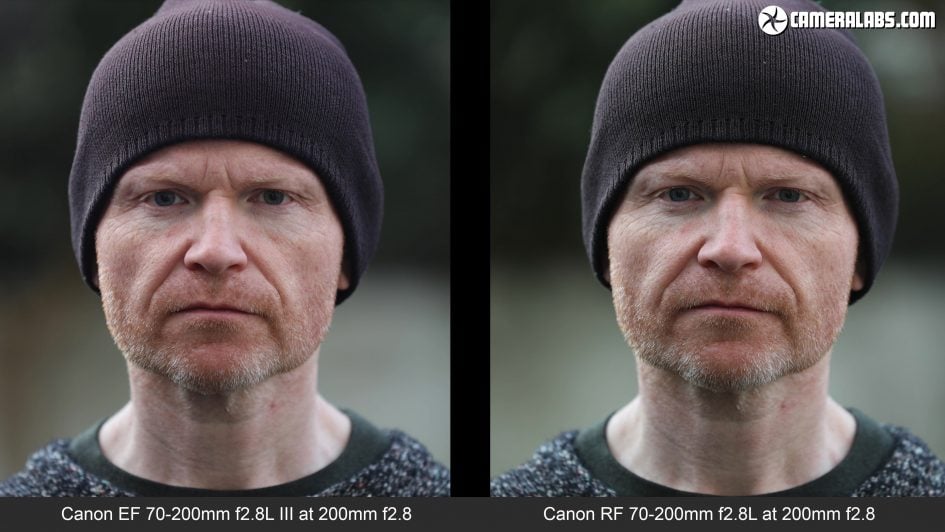
Above: And finally at 200mm f2.8 with the EF 70-200mm f2.8L III on the left and the RF 70-200mm f2.8L on the right.
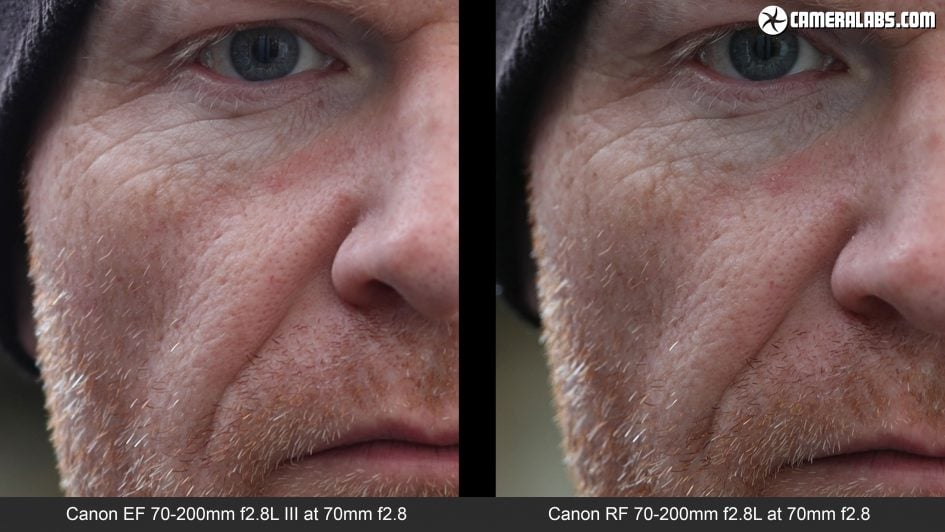
Above: I’d say there’s very little to choose between them in terms of rendering in the background, and if you look closely at my eyes and beard, both are also capturing a tremendous amount of sharp detail. I should add that during this test though, the newer RF 70-200mm seemed to deliver more perfect hits with face and eye detection than the older EF model adapted to the EOS R.
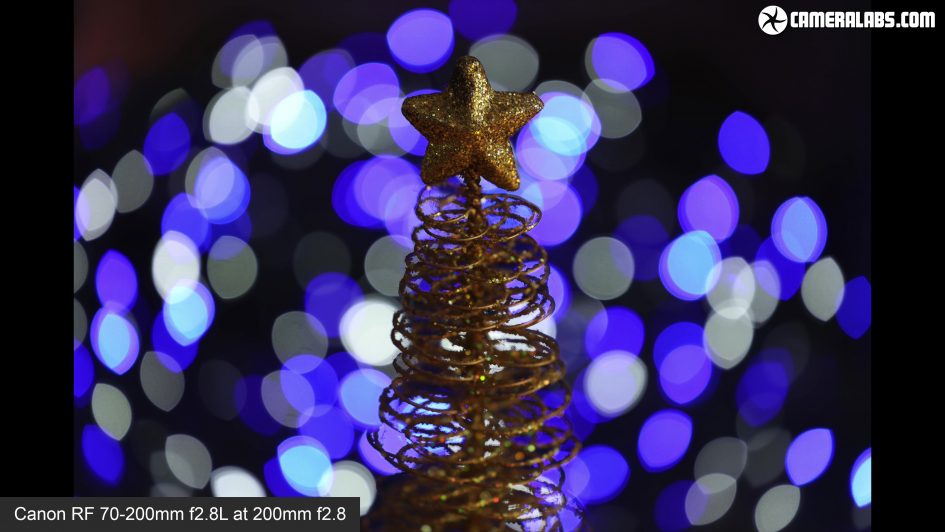
Above: But what about bokeh blobs I hear you cry, or maybe those were just the regular voices in my head. Here’s a closeup of an ornament from 1.2m away with the RF 70-200mm at 200mm f2.8, where the blobs are nice and large and exhibiting the cat’s-eye effect towards the edges and corners.
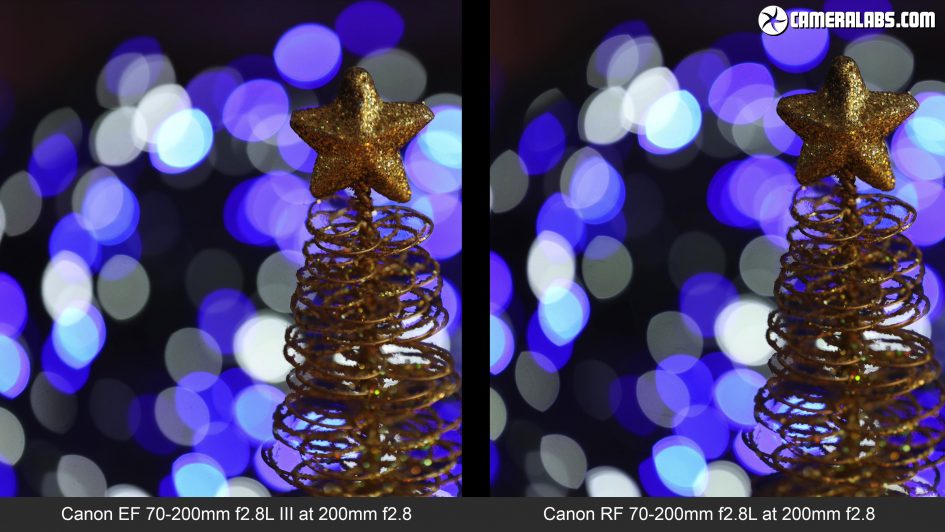
Above: Now let’s go through the apertures with the older EF 70-200mm on the left and the newer RF version on the right, and as a quick aside, I actually had to adjust the older EF lens to 145mm here to match the field of view of the RF at 200mm due to focus breathing differences at close range. Anyway, here they are at f2.8 where both lenses are delivering similarly-sized blobs with a similar degree of cats-eye shapes.
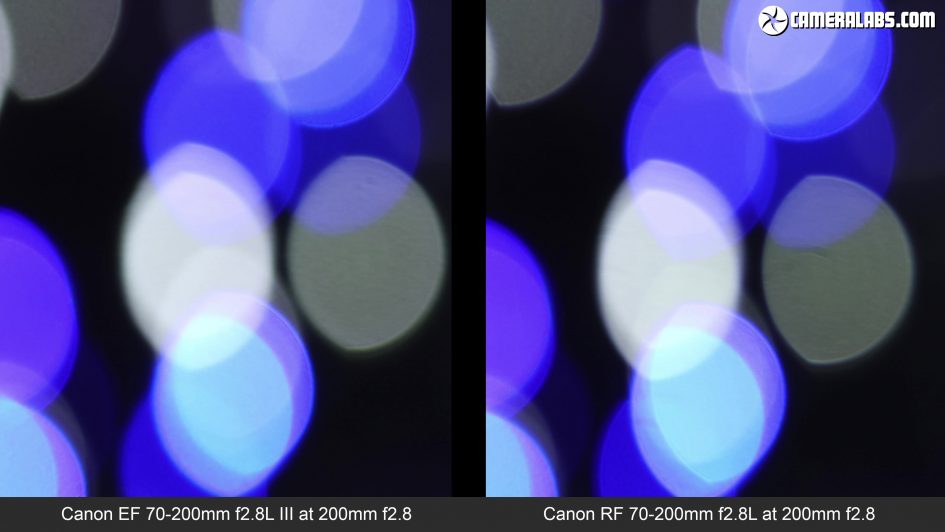
Above: Look closely though and you may notice the EF blobs on the left look a little softer around the edges than the RF version on the right where they look crisper. There’s no right or wrong here, only personal preference.
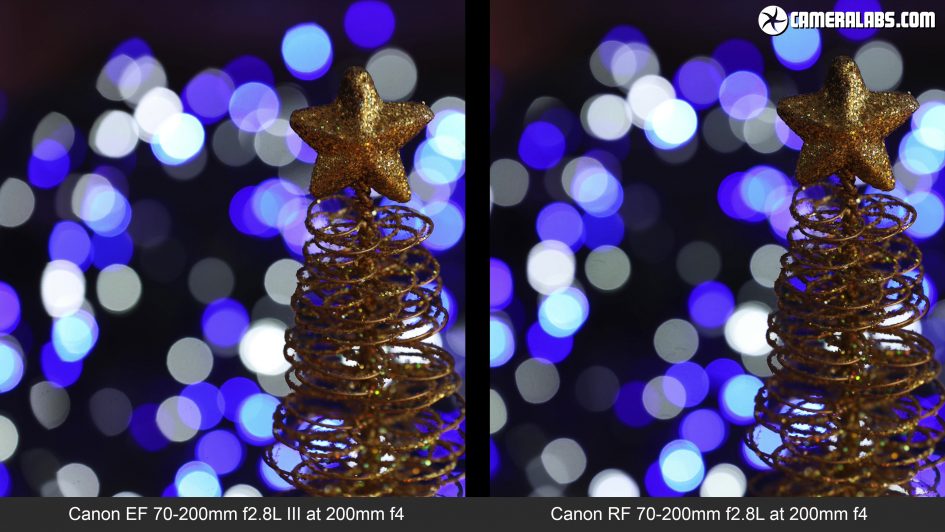
Above: As I close the aperture on both lenses, here at f4, you’ll see a slightly different shape from the eight blade aperture system of the EF lens on the left compared to the nine-blade RF version on the right, but nothing decisive, and beyond the maximum aperture they also share similar edge definition.
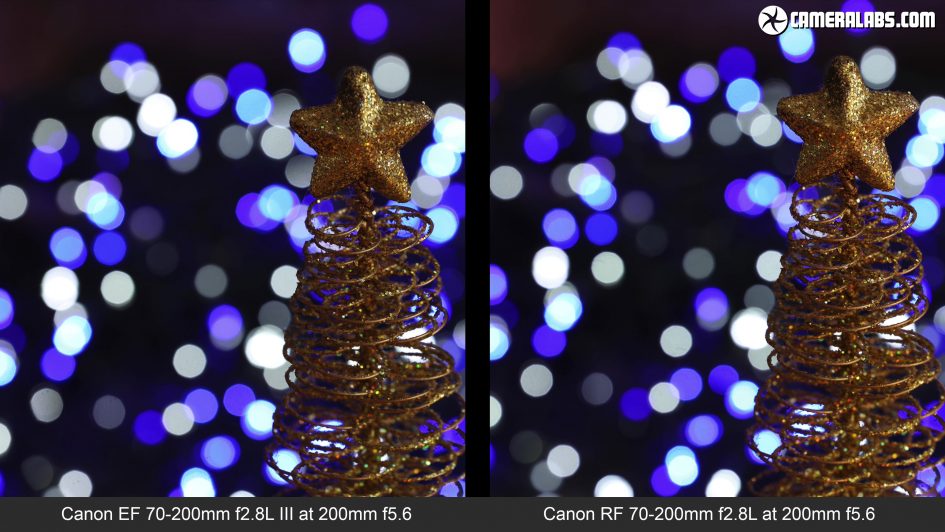
Above: Both lenses closed to f5.6.
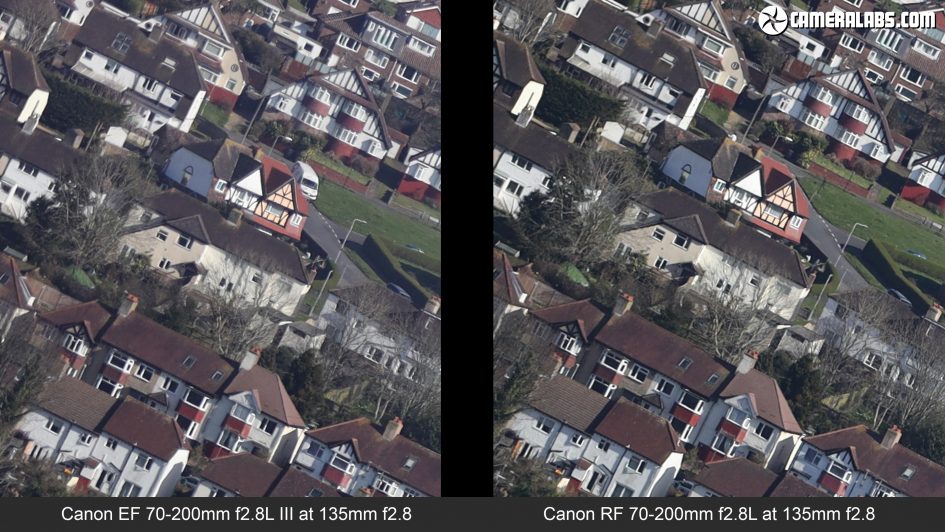
Above: Here’s a comparison I made with both lenses focused to infinity with the horizon angled so it reached into both corners where lesser lenses struggle. I’ve zoomed-into the top left corner here when both lenses were set to 135mm f2.8. Pixel peeping may reveal tiny differences in sharpness and contrast, but overall, I’d say they’re delivering very similar results. But the newer RF version is doing it with fewer optical elements, and a barrel that’s shorter and lighter
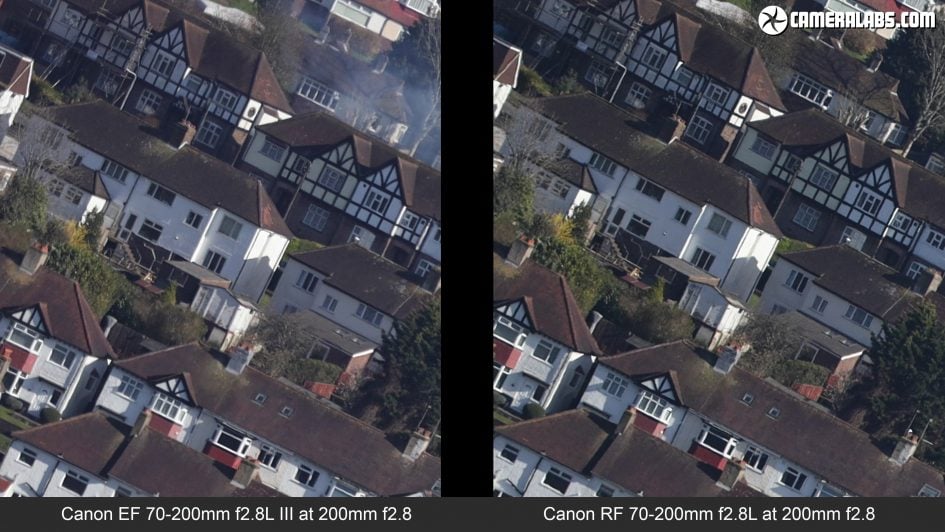
Above: The same test but at 200mm f2.8. See my full review video at the top of this page for more detailed tests and analysis.
Check prices on the Canon RF 70-200mm f2.8L at Amazon, B&H, Adorama, or Wex. Alternatively get yourself a copy of my In Camera book or treat me to a coffee! Thanks!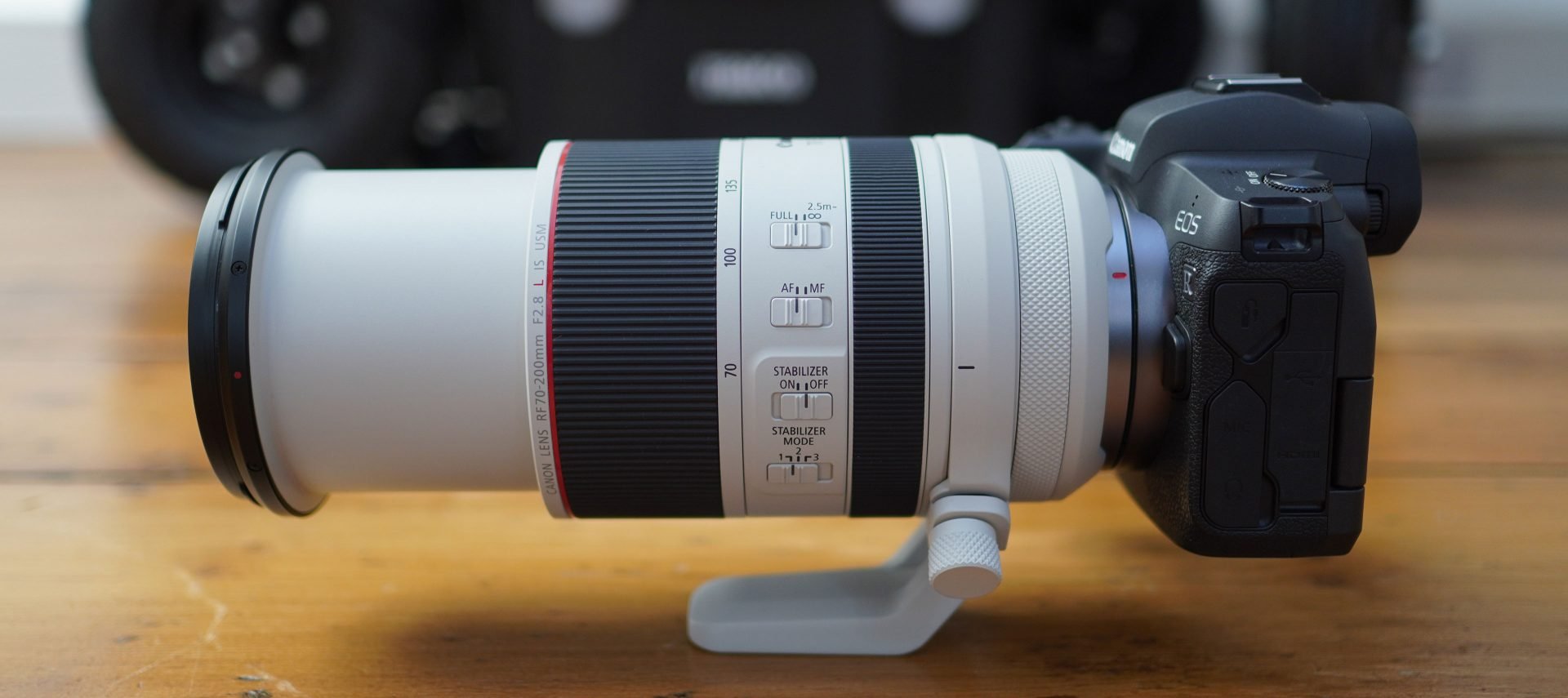
 The Canon RF 70-200mm f2.8L IS USM is a pro zoom that exploits the benefits of both mirrorless and modern optical design to deliver a truly unique proposition. It essentially matches the optical quality of the superb EF 70-200mm f2.8 Mark III, but with a barrel that’s two thirds the weight and, when set to 70mm, three-quarter’s the length. Event shooters will greatly appreciate the benefit of a noticeably lighter lens, plus the shorter barrel allows it to stand up for transportation in many bags rather than lying down. Canon’s also improved the image stabilisation, delivered better closeups, quietened the motors and thrown-in a cylindrical white lens hood with a filter window. In my tests, focus breathing may have reduced the benefit of the closer focusing distance, but the RF still delivers a bigger and sharper image than the EF version at their minimum distances, and while some may be sceptical over the switch from metal parts on the EF version to engineering plastic on the RF model, I’m not overly concerned - these new materials are tougher than you may think. A thornier issue is whether the extending barrel will suck in any dust or moisture, but the use of various air filters and an impressively robust mechanism are certainly reassuring - only time will tell though. There’s also the fact the new lens is comfortably more expensive than the already excellent Mark III EF version, but if you value saving almost half a kilo in weight, not to mention enjoying greater portability, sharper closeups and better stabilisation, then the RF 70-200mm f2.8L IS USM comes highly recommended.
The Canon RF 70-200mm f2.8L IS USM is a pro zoom that exploits the benefits of both mirrorless and modern optical design to deliver a truly unique proposition. It essentially matches the optical quality of the superb EF 70-200mm f2.8 Mark III, but with a barrel that’s two thirds the weight and, when set to 70mm, three-quarter’s the length. Event shooters will greatly appreciate the benefit of a noticeably lighter lens, plus the shorter barrel allows it to stand up for transportation in many bags rather than lying down. Canon’s also improved the image stabilisation, delivered better closeups, quietened the motors and thrown-in a cylindrical white lens hood with a filter window. In my tests, focus breathing may have reduced the benefit of the closer focusing distance, but the RF still delivers a bigger and sharper image than the EF version at their minimum distances, and while some may be sceptical over the switch from metal parts on the EF version to engineering plastic on the RF model, I’m not overly concerned - these new materials are tougher than you may think. A thornier issue is whether the extending barrel will suck in any dust or moisture, but the use of various air filters and an impressively robust mechanism are certainly reassuring - only time will tell though. There’s also the fact the new lens is comfortably more expensive than the already excellent Mark III EF version, but if you value saving almost half a kilo in weight, not to mention enjoying greater portability, sharper closeups and better stabilisation, then the RF 70-200mm f2.8L IS USM comes highly recommended.



